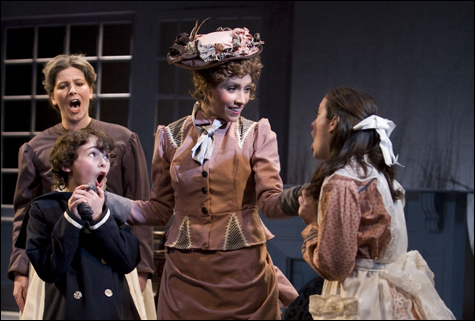
THE TURN OF THE SCREW: Astounding, phenomenal, superb were adjectives that came to mind. |
Some weeks Boston has such musical riches, one wouldn’t want to be anywhere else. After a slow start to 2008, we’ve been treated to superlative concerts of contemporary chamber music and big orchestral events, intimate soirees of theater and cabaret songs, and a powerful production of a modern opera classic. Who needs to go to New York?
James Levine returns to lead the Boston Symphony Orchestra this week, but in his absence, two guest conductors have delivered the goods. Charles Dutoit was back with a satisfying program that began with Swiss composer Frank Martin’s elegant and unsettling Petite symphonie concertante, for harp (Ann Hobson Pilot), harpsichord (Mark Kroll), piano (Randall Hodgkinson), and two string orchestras (the BSO). Sir Colin Davis led it last at Symphony Hall in 1984 (with Pilot and Kroll), and Dutoit led it at Tanglewood in 1990. It was refreshing to hear the offbeat accents of Martin’s inexorable machine, though one could imagine it all being more overtly seductive or insinuating.
It’s almost always a treat to hear the Cubist angles and memorable tunes of Prokofiev’s First Violin Concerto. Dutoit and the 31-year-old German virtuoso Viviane Hagner (in her BSO debut) kept it from wading in saccharine. In 1923, it was considered all but unplayable. Now it’s tossed off with almost too much abandon. The great performances (Joseph Szigeti under Sir Thomas Beecham is the benchmark) are also meditative and daringly exploratory; this one was merely enjoyable.
The big hit was Saint-Saëns’s Third Symphony, the “Organ Symphony,” with BSO organist James David Christie, providing the reverberating buzz of the newly refurbished Symphony Hall organ not only in the magnificent, grandiloquent outbursts but also in the quieter undercurrents (like a cellphone on mute vibrating in your pocket). Dutoit and the orchestra made this frequently trudged-out warhorse seem like a young stallion.
British conductor Mark Elder led a gripping version of a real rarity: Shostakovich’s Symphony No. 4, withdrawn (with Stalin’s encouragement) before its premiere in 1936 and finally resurrected in 1961 (the BSO’s only previous performance was 30 years ago). It’s more than an hour long and has Shostakovich’s largest orchestra (six flutes and/or piccolos; eight horns — though Elder used nine). The composer called it his artistic credo. Two long, complex movements surround a short scherzo-like Moderato con moto. But it’s constantly veering from shrieks of agony to laughing carnival calliope, never staying in the same place for long. If you compared it to a painter, Hieronymus Bosch might come to mind. The playing, with antiphonal first and second violins, ranged from ticklish to brutal but was always clear and pointed, even delicately pointillist. Elder spoke to the audience before the downbeat, and his excitement about the piece seemed to galvanize both the players and the audience. And perhaps himself as well.
This was preceded by a hollow rendition of the Sibelius Violin Concerto with 37-year-old Russian virtuoso Vadim Repin playing as if the sound of his instrument were more important — much more important — than Sibelius’s music. It was an extroverted, externalized version of a piece that continues to engage because of its mysterious inwardness. Repin steamrollered over Elder’s unpointed accompaniment. The only profile in view was Repin’s.